|
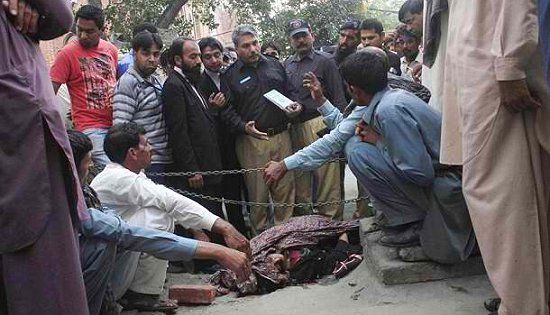
Police
collect evidence near the body of Farzana Parveen, who was
killed after being set upon by members of her own family outside
a court in Lahore, Pakistan. (Image courtesy: www.nationalturk.com) |
Government’s
failure leads to a pregnant woman being stoned to death
By Asian Human Rights
Commission
May 29, 2014
HONG KONG – The world
is once again shocked by the news of the stoning to death of a
25-year-old pregnant woman, Farzana Parveen Iqbal, in Pakistan. The
stoning took place before the Lahore High Court where she had attended
due to a summons. The stoning was carried out by 20 members of her own
family including her father and two brothers.
The reason for the stoning
was that Frazana had married a person of her own choice and she was
pregnant with a child from that marriage. Her family did not approve
the marriage and was forcing her to marry another person of their
choice who happened to be her cousin. The father who was aware of
Farzana’s marriage filed a false complaint of abduction against her
husband. The police filed charges on the basis of the father’s
complaint. It appears that the filing of the complaint was done with
the purpose of bringing her out from hiding with the intent to kill
her.
It is evident that the
police have been a part of this conspiracy as they should have
investigated the complaint before filing such a charge. Bringing
persons to court with the intent to kill them, particularly in cases
relating to honour killings and blasphemy cases is a common practice
in Pakistan and the police would have naturally been aware of the
situation in this instance. It was when Farzana arrived at the court
in order to present her case to the judge that she was already married
that the brutal killing took place.
The culprits who took part
in the stoning did so in broad daylight and in full view of crowd of
people and then manage to escape as there was no attempt to stop or
arrest them. As the incident took place before the High Court of
Lahore the police would have been present in large numbers at the
scene as they are always present when the High Court is in session. In
fact, Mr. Iqbal, Farzana’s husband told the BBC that the police stood
by and did nothing to prevent the stoning. He stated, “We were
shouting for help, nobody listened. One of my relatives took off his
clothes to capture the attention of the police but they did not
intervene. They watched Farzana being killed and did nothing”.
No attempt whatsoever was
made to protect the victim or to obstruct the perpetrators. Farzana’s
father later surrendered to the police but as is usual in such
instances showed no regret no remorse and admitted openly that he has
done this murder.
According to the Human
Rights Commission of Pakistan (HRCP), the number of women falling
victim to the so-called “honour killings” is enough to dispel all
illusions about any interest in saving their lives. In 2013 alone, the
HRCP recorded the deaths of nearly 900 women in “honour” crimes from
media reports. These women were killed because the state did not
confront this feudal practice supported by religious fundamentalism
and bigotry.
The Aurat Foundation, a NGO
working on the rights of women, states around 1,000 Pakistani women
are killed every year by their family members in honour killings. The
true figure is probably many times higher since the Aurat Foundation
only compiles figures from newspaper reports. The government does not
compile national statistics.
In any case, the killing of
persons who marry against the consent of the family, which is usually
identified by the term ‘honour killings’ is a frequent and a common
phenomenon in Pakistan. Furthermore, using a summons of a court as a
subterfuge to bring persons out of hiding so that such killings can
take place is also a frequent phenomenon. Such situations have arisen
both in terms of honour killings and killings relating to allegations
of blasphemy.
The most famous incident of
protest against this whole manipulation of law in order to kill
victims involved Bishop John Josephs, who as a symbolic act of protest
shot himself to death.
Thus the government of
Pakistan is fully aware of this horror that is being regularly
perpetrated but has failed to take any meaningful action in order to
bring this practice to an end.
The issue is not about
arresting a few persons after the incident. The fundamental issue is
the lack of a comprehensive plan on the part of the government of
Pakistan to deal with the problem. As long as the government fails to
develop a comprehensive plan and implement it, with the cooperation of
the law enforcement agencies, honour killings will continue to take
place in Pakistan.
The Asian Human Right
Commission (AHRC) over a long period of time has consistently drawn
the attention of the government of Pakistan about this practice and on
every incident of this sort renewed calls to the government to give
due consideration to this abominable practice. Similar calls have also
been made to the government from the local sources as well as from the
international community.
Following the killing of
Farzana Parveen Iqbal the UN High Commissioner for Human Rights, Navi
Pillay, issued a comprehensive statement in which, among other things,
she has stated that the Pakistani government must take urgent measures
to put an end to the continuous stream of so called honour killings
and other forms of violence against women. They must also make a much
greater effort to protect women like Farzana. The fact that she was
killed on her way to court, shows a serious failure by the state to
provide security for someone who – given how common such killings are
in Pakistan – was obviously at risk.
In 2004, former President
Pervez Musharaf, defined honour killings as murder, and brought in a
law to that effect. However, the eradication of such heinous criminal
acts cannot be achieved only by public announcements or through the
enactment of laws. Any genuine and effective action lies in the area
of the implementation of the law.
It is in this area that the
government of Pakistan has proven itself completely ineffective. The
system of policing and law enforcement in Pakistan is a law unto
itself and even the government is unable to move it even for the
purpose of dealing with the worst of the crimes.
The failure of the
government to carry out its responsibility lies in its unwillingness
and incapacity to exercise control over the policing establishment. If
the government proves powerless to move its police to implement the
law, and in particular, to deal with the such heinous crimes then no
one can feel safe within the territory of Pakistan.
The AHRC also wishes to
highlight the need that greater pressure must be brought on the
government by the international community to ensure that it takes
suitable action to end the police neglect relating to honour killings
and all other forms of violence against women. Mere ritual
condemnation after honour killings take place is unlikely to bring
about any improvement in the situation at present.
The international community
including the UN agencies must engage with the government of Pakistan
in order to come with an agreement on a practical scheme of action to
deal with this situation once and for all. If no such serious attempt
is made by the international community it will not convince the
persons who are threatened with future attacks of this nature as well
as the population of Pakistan which faced with a powerless situation
in the face of such horrendous crimes. The failure of the law
enforcement agencies to deal with such crimes will only increase the
vulnerability of women in the country.
The AHRC calls upon the
government of Pakistan not to let Farzana Iqbal’s death be in vain.
The people of Pakistan and people of goodwill throughout the world
have a right to expect that the government will show its moral
indignation and outrage against the horror perpetrated by way of
honour killings and other severe violence against women and vulnerable
groups.
Army encounters NPA
rebels, seizes high-powered firearms
By DPAO, 8ID PA
May 27, 2014
CAMP LUKBAN, Catbalogan
City, Samar – Troops under 43rd Infantry Battalion, 8th Infantry (Stormtroopers)
Division, Philippine Army, encountered New People’s Army rebels
operating in Samar at around 5:30 p.m. on May 26, 2014 at Brgy.
Mahayag, Matuguinao, Samar.
Based on the report of Lt.
Col. Glen Jun C. Calambuhay, Commanding officer of 43IB, his troops
were conducting security operations at the vicinity of Bgy Mahayag,
Matuguinao, Samar when undetermined number of NPA rebels fired upon
them.
A firefight ensued
afterwhich the rebels withdrew. Two (2) NPA rebels died as a result of
the firefight. Likewise, the government troops were able to recover
one (1) 5.56 armalite rifle, one (1) 5.56 Baby armalite rifle and one
(1) 40mm M203 grenade launcher. The government troops suffered no
casualties in the said encounter. Pursuit operation is ongoing as of
press time.
Maj General Jet B Velarmino,
Commander of the 8th Infantry Division lauded his troops
accomplishment, “I take pride as your commander of your dedication to
service which resulted to the accomplishment of your given mission.”
However, he expressed his
sympathy to the families and relatives of the NPA rebels who were
killed. “It is very tragic that they have taken arms against the
Filipino nation when only through peace can development and social
justice be attained.”
Further, he stressed, "45
years of armed struggle have not solved any of our problems. Rather,
it has caused more problems to our society. I am therefore encouraging
NPA members to take advantage of the government's social integration
program and other local programs designed to bring back rebel
returnees to the mainstream of the society. It will provide you an
opportunity to be with your loved ones and community and together we
shall solve our problems in a peaceful way."
Hawaii lawmaker
visits Philippines
Vice Speaker Mizuno in Leyte
assisting with typhoon relief efforts
Press Release
May 24, 2014
HONOLULU, Hawaii –
Hawaii State House of Representatives Vice Speaker John M. Mizuno is
currently in the Philippines visiting relatives and government
officials while assisting the Gawad Kalinga Community Development
Foundation (GK) in the location of two sites where GK plans to build
two villages. One village will be built in Bohol where a 7.2 magnitude
earthquake struck on October 19, 2013 and one in Leyte, which was
devastated by super typhoon Yolanda.
 On Tuesday, May 27th, Vice
Speaker Mizuno plans to visit with officials in Tacloban City between
10am and noon, and meet with officials in Barugo Town around 2pm. On
Thursday, May 29th he will be visiting Bohol and make a site visit for
a possible village.
On Tuesday, May 27th, Vice
Speaker Mizuno plans to visit with officials in Tacloban City between
10am and noon, and meet with officials in Barugo Town around 2pm. On
Thursday, May 29th he will be visiting Bohol and make a site visit for
a possible village.
Funds were raised in Hawaii
by the Congress of Visayan Organizations (COVO) through various
activities, such as concerts and the selling of T-shirts. COVO
president is May Besario Mizuno, wife of the Vice Speaker. Last month
a Memorandum of Agreement (MOA) was signed between COVO and GK-USA
committing a dollar-for-dollar match with funds raised by COVO to
build two villages with a minimum of 20 houses that will bear the name
"COVO Aloha GK USA Village".
"The transformation of our
relief efforts, focused on rebuilding housing projects in these
devastated areas, will be retrofitted to withstand future typhoons"
said May Mizuno, COVO President. "We believe this MOA brings our
efforts in helping the victims of typhoon Yolanda full circle."
"I am proud of my wife's
work to unite the Filipino community in Hawaii for a great cause"
added Vice Speaker John Mizuno. "This touches our hearts on a very
personal note because our family members survived super typhoon
Yolanda and they too are working to rebuild their home."
COVO continues to raise
funds for relief efforts following typhoon Yolanda and hopes to have
similar opportunities in the future to rebuild devastated Philippine
communities.
Ortigas names finalists
of Build Forward archi-design competition
Ten most innovative designs
to undergo structural review
Press Release
May 13, 2014
MANILA – Ortigas &
Co. recently unveiled the names of the 10 student finalists, who
topped Build Forward, a nationwide competition for the design of
climate-adaptive houses and school buildings.
Earlier this year, the
developer, in partnership with the Department of Science and
Technology (DOST) and Habitat for Humanity Philippines, launched a
landmark campaign, which challenged architecture students from
different Philippine colleges and universities to come up with designs
that can adapt to the changing weather conditions in the country.
Three major factors were considered, namely: strength, feasibility,
and innovation. The use of locally sourced and readily available
materials was also encouraged.
The finalists for the house
design category are:
• “Haligi” by Jonie Agas and
Regine Deximo, 3rd year students from UP-Diliman (advised by Arch.
Nicolo del Castillo) is typical of a traditional Filipino house. The
design proposes wood and bamboo as primary materials with a concrete
core to serve as storage of food and emergency kits.
• “Bambox Hut: Amphibious
Housing for Taclobenos” by Lara Therese Cruz, 5th year student from
UST (advised by Arch. Jonathan Manalad), boasts of its ability to
stand rigid through strong winds and earthquakes and to float in the
gush of floods.
• “Bahay Panalag Laban sa
Kalamidad” by Menard Navarro, Joyce Mari Linchangco, Paul Allan Bansil,
and Jon Ilio are students from Mapúa (advised by Arch. Albert S.
Zambrano), is made of multiple hexagonal units, a design that makes
the structure more resistant to strong earthquakes and flood loads.
• Odessa Kaye Bulahan, 5th
year student in the University of San Carlos (advised by Arch. Danilo
Ravina), uses an Earth Technology called ICEB. Interlocking Compressed
Earth Block (ICEB) is a cement stabilized Earth-based construction
material that has high compressive strength, which could be used as a
load-bearing wall or shear wall for a two or three-storey building.
• “Neobalay” by Christian
Jay Noble, 5th year student from the Technological Institute of the
Philippines (advised by Arch. Simoun T. Ong), attempts to have a
modified neo disaster-resilient bahay kubo that could withstand
intensity 8 earthquakes and a typhoon that has a wind gust of 250 kph.
The finalists for the school
design category are:
• “Taklob: A Low-Cost and
Disaster Resilient School and Evacuation Center” by Mervin Afan,
Corenne Martin and Rafael Khemlani, 4th year students from UP- Diliman
(advised by Arch. Nicolo del Castillo), proposes a structure which can
easily adapt during summer and typhoon seasons because of its openness
for wind circulation as well as storm shutters.
• Emmanuel Ornos, Everette
Rabbon and Christopher De Vera, 4th year students from the University
of Northern Philippines (advised by Arch. Fatima Alonzo), focus on
elevation which can easily adapt in times of typhoons and floods.
• “Incubator: A
School-Disaster Relief Structure” by Marvin Arellano and Colleen Ong
, 4th year students from UP-Diliman (advised by Arch. Nicolo del
Castillo), presents a plan featuring louvered vents ideal for tropical
climates and a wide corridor as an activity area in times of disaster.
• “Talukab” by Jose Ruel
Fabia, Kurt Cleon Yu and Maria Angela Luna, students also from UP-Diliman
(advised by Nicolo del Castillo), is designed as a school and an
evacuation with a square plan that will protect people from different
types of calamities.
• Gino M. Diongzon and
Michael P. Lagason, 4th year students from the University of the
Assumption (advised by Erick Embang), offer collapsible walls ideal
for emergency evacuations and desks, which can be converted into beds
when needed.
The said designs will be
sent to Magnusson Klemencic Associates, based in Seattle, Washington,
USA and Rowan Williams Davies & Irwin (RWDI) Consulting Engineers and
Scientists headquarters in Guelph, Ontario, Canada to undergo
structural review by experts, and the designs will also be reviewed by
experts in the Philippines. The winning entry will be used by Habitat
for Humanity Philippines in the construction of new houses in
Yolanda-ravaged areas.
“In less than two months
since we launched the competition, we were able to generate more than
100 entries from architecture students in different colleges and
universities across the Philippines. Finalist selection proved rather
tough because of the excellent quality of designs we received. The
future of architecture in the Philippines is looking bright, and so
are the prospects for an ongoing campaign to Build Forward,” says Joey
F. Santos, General Manager of the Real Estate Division, Ortigas & Co.
All designs are posted
online atwww.buildforward.com.ph and are public documents, which every
designer can build on. The grand winner will be announced early June.
For more updates, like Build Forward on Facebook, or follow its
twitter handle @BuildForwardPH.
DESIGN PERSPECTIVE
|
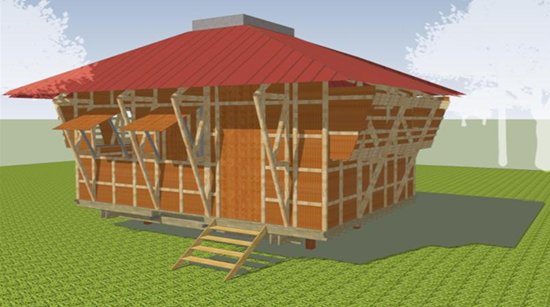
A
team from University of the Philippines – Diliman advised by
Arch. Nicolo del Castillo, made a house design which modernizes
the traditional bahay kubo by adding a cement core in the house
to act as storage for food and emergency supplies. |
| |
|

“Bambox
Hut” is a home design concept by Lara Therese Cruz from the
University of Santo Tomas, under the tutelage of Arch. Jonathan
Manalad, which is designed to withstand strong winds,
earthquakes and floods. |
| |
|
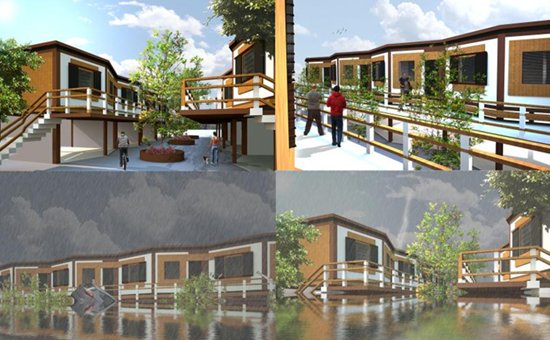
Under
the guidance of Arch. Albert S. Zambrano, a team from Mapúa has
conceptualized hexagonal-shaped house, a design which makes the
structures more resistant to calamities. |
| |
| |

The
home concept of Odessa Kaye Bulahan of the University of San
Carlos, advised by Arch. Danilo Ravina, uses Interlocking
Compressed Earth Block (ICEB), an earth technology which ensures
the house to have high compressive strength. |
|
| |
|

The
octagon shaped home design concept, dubbed “Neobalay”, by
Christian Jay Noble from Technological Institute of the
Philippines, advised by Arch. Simoun T. Ong boasts not only its
ability to withstand calamities, but also its resource
efficiency. |
| |
|

“Taklob”
school concept by a team from University of the Philippines –
Diliman advised by Arch. Nicolo del Castillo, was designed to
adapt easily between the sunny and rainy seasons through its
features. |
| |
|

A
team from University of Northern Philippines advised by Arch.
Fatima Alonzo conceptualized a school design with a high
elevation which will allows it to withstand floods. |
| |
|

A
team from UP Diliman, advised by Arch. Nicolo del Castillo,
created a school concept named “Incubator”, which has vents
which expel hot air suited for the tropical climate in the
Philippines, and had wide spaces for its restrooms and
classrooms, enough for evacuees. |
| |
|
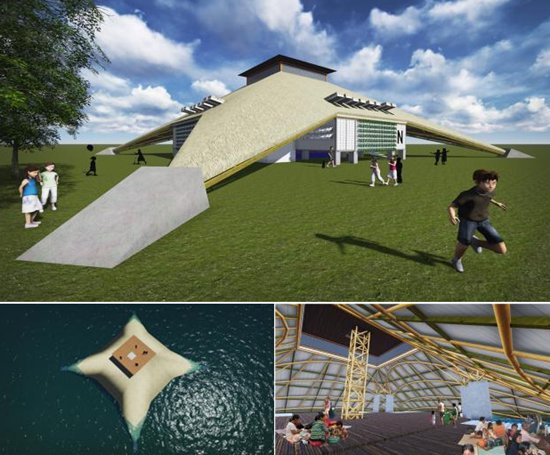
Inspired
by the shell of a turtle, a team from University of the
Philippines - Diliman with the guidance of Arch. Nicolo del
Castillo designed a school concept, “Talukab”, which gives much
protection to evacuees during calamities. |
| |
|
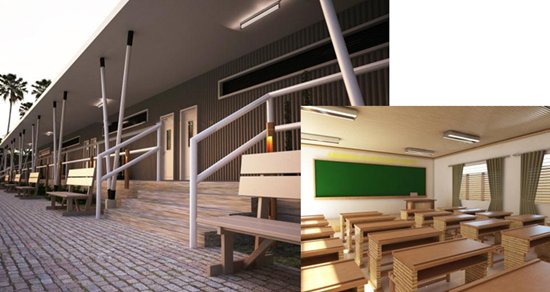
Under
the guidance of Erick Embang, a team from the University of
Assumption crafted a school concept, which could easily be
turned into an evacuation center with features such as
collapsible walls, and desks that can turn into beds. |
Related
article: DOST, Ortigas, Habitat for Humanity
join forces to build climate-adaptive houses
Philippine Army
Engineers and Republic of Korea Armed Forces completes rehabilitation
of Naga-Naga Elementary School in Leyte
By DPAO, 8ID PA
May 10, 2014
CAMP LUKBAN, Catbalogan
City, Samar – Joint effort of the Philippine Army Engineers and
Republic of Korea Armed Forces led to another successful completion of
the rehabilitation of the Naga-Naga Elementary in Palo, Leyte. The
school suffered much damage during the onslaught of ST Yolanda which
left most of its school buildings and classrooms inoperable.
No less than the commander
of the 8th Infantry Division, Philippine Army attended the completion
celebration of the rehabilitated school facilities Naga-Naga
Elementary at Barangay Naga-Naga, Palo Leyte on May 9, 2014 along with
Hon. Remedios Petilla, Mayor of Palo Leyte and Ms. Divina M. Monhe,
Ph.D. Principal of Naga-Naga Elementary School.
Also present during the
celebration were the troops under South Korean Joint Support Group
Philippines (SK-JSGP) military contingent led by Col. Lee Chul-won and
troops under Philippine Army Engineer units led by Maj. Danny Rey
Montemayor. The combine troops of SK-JSGP and Philippine Army
Engineers were instrumental in the repair and rehabilitation of the
school facilities. It was the 8th school rehabilitated and there are
still 10 schools currently undergoing repair and rehabilitation works.
Various performances on
dancing skills were presented by the South Korean troops, Philippine
Army Engineers, PNP personnel and students from different elementary
schools of Palo Leyte. The performances were highlighted by the
surprise appearance of RAINBOW, a popular South Korean girl K-Pop
group. The performance of the K-Pop group mesmerized the crowd
especially the South Korean troops and egged the group for more songs.
The K-Pop group obliged and ended up performing three songs to the
delight of the crowd.
Meanwhile, the first batch
of students of the heavy equipment seminar initiated by the SK-JSGP
graduated last May 9, 2014. The graduation was graced by Hon. Leopoldo
Dominico Petilla, Governor of Leyte and Maj. Gen. Jet B. Velarmino AFP.
From March 31, 2014, the students underwent a series of heavy
equipment operation training for crane, excavator, pay-loader,
bulldozer, and buck hoe. The training of the 39 heavy equipment
operation students was accredited by TESDA.
In his message, Maj. Gen.
Velarmino AFP lauded the endeavors of the SK-JSGP. He said, “I would
like to express my deepest admiration and high regard to our comrades
from the Republic of Korea Support Group Philippines "Araw
contingents" whose love and passion for our fellow Filipinos brought
new hope for the country. Your sweat and sacrifices might not be
enough to bring back the lives lost in the super typhoon, but your
sweat is more than enough to keep us going with our lives and your
effort will forever be etched in our hearts and minds.”
PH-US Balikatan
2014 Cooperative Health Engagement in Tacloban City
By DPAO, 8ID PA
May 10, 2014
CAMP LUKBAN, Catbalogan
City, Samar – Troops under the Armed Forces of the Philippines and
the United States Armed Forces that formed part of the Balikatan
Exercises 2014 conducted cooperative health engagement or medical
mission at Fishermen’s Village Elementary School, Brgy. 88, San Jose.
Tacloban City on May 10, 2014.
Maj. Gen. Emeraldo C.
Magnaye AFP, the Balikatan 2014 AFP Lead Directorate and Brig. Gen
Nelson of U.S. Marine Corps led the troops in conducting medical
treatment and veterinary services from 9:00a.m. up to 4:00p.m.
The activity was also
attended by Atty. Irene Chiu, the executive assistant of the City of
Tacloban and Hon. Emelita S. Montalban, Barangay Chairwoman of the
host barangay. The activity benefited 544 medical patients broken down
into 196 pedia and 348 adult patients. Likewise, 50 dogs and a cat
received anti-rabies vaccinations from the veterinary service.
Atty. Chiu in her message
appreciated the presence of U.S. and AFP troops in rendering medical
mission in their city even after six months when the tragedy struck
the city. “You were here during the aftermath of the super typhoon and
you are here again six months after. With that, I would like to
acknowledge and thank the unsung heroes of the Philippine Army and the
U.S. Marines and everyone who responded to Tacloban City during the
early part of the tragedy and helped us regain our strength,” she
said.
On the part of U.S. forces,
Brig Gen Nelson commenting on why they have chosen Tacloban City for
the medical mission said, “We felt that after the super typhoon
Yolanda, Tacloban City is a great place to anchor Balikatan. We want
to show our friendship, and this activity is also a good way to get
back to the great people, the Filipinos. I was here three days after
the super typhoon and what I see now six months after the typhoon is
vast improvement. People have come together in rebuilding communities.
The resilience of the Filipino people is amazing and very heart
warming.”
Commenting on the Balikatan
medical mission in Tacloban City, Maj. Gen. Jet B. Velarmino AFP said,
“The Balikatan 2014 cooperative health engagement or medical mission
at Brgy 88, Tacloban City manifests that the ‘Bayanihan’ spirit knows
no boundaries, as it lingers even among other nationalities, even
among U.S Forces. Your Army in Eastern Visayas strongly supports this
kind of activity as it puts the people's welfare and well-being above
all other considerations.”